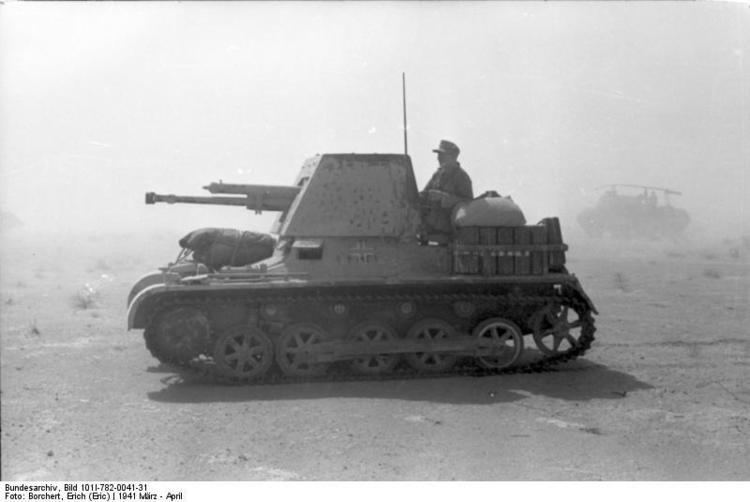Type Tank destroyer In service 1940–43 | Used by Nazi Germany | |
 | ||
The Panzerjäger I (English: Tank Hunter 1) was the first of the German tank destroyers to see service in the Second World War. It mounted a Czech Škoda 4.7 cm (1.9 in) cm PaK (t) anti-tank gun on a converted Panzer I Ausf. B chassis. It was intended to counter heavy French tanks like the Char B1 that were beyond the capabilities of the 3.7 cm PaK 36 anti-tank gun and served to extend the life of the obsolete Panzer I tank chassis. 202 Panzer I were converted to the Panzerjäger I in 1940 and 1941. They were employed in the Battle of France, in the North Africa Campaign and on the Eastern Front.
Contents
Design and production
The Panzer I turret was removed and a fixed gun shield added to protect the armament and crew. The anti-tank gun was mounted on a pedestal in the fighting compartment with the wheels, axle and trails removed; it retained its original gun shield. It normally carried 74 anti-tank and 10 HE shells. Alkett and contractors built 202 vehicles, the first series of 132 by Alkett in 1940. Ten of the second series of 70 were assembled by Alkett while the remainder were assembled by Klöckner-Humboldt-Deutz in 1940 and 1941. Vehicles in the second series are recognizable by their seven-sided gun shield while the first series had a five-sided shield. The formal name of the equipment was 4.7 cm PaK(t) (Sf) auf Panzerkampfwagen I ohne Turm, translating as "4.7 cm anti-tank gun (Czech) on turretless Pz.Kpfw. I".
Organization
Panzerjäger I's were generally organized into nine-vehicle companies, with three companies per battalion. For the French Campaign (only) anti-tank battalion Panzerjäger-Abteilung 521 had only six vehicles per company. With two exceptions they were only used by independent anti-tank battalions during the war; after the Balkan Campaign, one company was assigned to the SS-Brigade Leibstandarte der SS Adolf Hitler and another to Panzerjäger-Abteilung 900 of Lehr-Brigade (mot.) 900 ("900th Motorized Training Brigade") in preparation for Operation Barbarossa.
Combat history
Anti-tank Battalions 521, 616, 643 and 670 had 99 vehicles in the Battle of France. Only Anti-tank Battalion 521 participated in the campaign from the beginning as the other three were still training until a few days after the campaign began but they were sent to the front as they finished their training.
Twenty-seven Panzerjäger I's equipped Anti-tank Battalion 605 in North Africa. It arrived in Tripoli, Libya between 18 and 21 March 1941. Five replacements were sent in September 1941 but only three arrived on 2 October, the others being sunk on board the freighter Castellon. At the start of the British Operation Crusader the battalion was at full strength but lost thirteen vehicles during the battles. Four more replacements were sent in January 1942 so that it mustered seventeen at the beginning of the Battle of Gazala. Despite the shipment of another three vehicles from September–October 1942, the battalion only had eleven by the beginning of the Second Battle of El Alamein. The last two replacements received by the battalion were in November 1942.
Anti-tank Battalions 521, 529, 616, 643 and 670 were equipped with 135 Panzerjäger I's for Operation Barbarossa. They were assigned as given below for the opening stages of the battle:
By 27 July 1941, Anti-tank Battalion 529 had lost four Panzerjäger I's. On 23 November 1941 it reported that it still had sixteen vehicles, although two were not operational. Most do not appear to have survived the Winter of 1941–42 as Anti-tank Battalion 521 reported only five on hand on 5 May 1942. Anti-tank Battalion 529 had only two on strength when it was disbanded on 30 June 1942. Anti-tank Battalion 616 seems to have been an exception as it reported all three companies had Panzerjäger I's through at least the fall of 1942.
Combat assessments
The 4.7 cm armor-piercing shells (Panzergranaten) are very good against 45 to 50 millimetres (1.8 to 2.0 in) thick armor at ranges up to 500 metres (550 yd) - sufficient to 600 metres (660 yd). Observation is very bad. You have to look over the shield to observe to the front, resulting in head shots (Kopfschüsse)! In effect the crew are blind when attacking in villages or against street barricades, M.G. nests and individual tanks.
The effective range of the 4.7 cm Pak(t) is 1,000 to 1,200 metres (1,100 to 1,300 yd) with a maximum range of 1,500 metres (1,600 yd). When attacking an enemy position equipped with anti-tank guns and artillery, as occurred near Mogilev and Rogachev, because of its high superstructure that presents a good target for artillery and anti-tank guns, the Panzerjäger is destroyed before it can get into action. When large shells explode close-by, fragments penetrate the thin armor, as occurred near Rogachev. Russian 4.5 cm (1.8 in) anti-tank guns already penetrate at 1,200 metres (1,300 yd) range. The 1. Kompanie lost 5 out of the 10 vehicles (Kampffahrzeuge) in such actions, of which only two could be repaired.
The good accuracy of this weapon was especially commented on. Usually a hit is obtained with the first shot at ranges up to 1,000 metres (1,100 yd). Penetration ability is too low for the necessary combat ranges in the desert. The chassis is too weak. The engine is overtaxed. Springs in the suspension are continuously breaking. In one case, three Mk II (Matilda II infantry tanks) were penetrated at a range of 400 metres (440 yd) by 4.7 cm tungsten-core armor-piercing shell (Pz.Gr. 40). It usually penetrates 60 millimetres (2.4 in) of armor. Therefore, a small percentage of these rounds are desired. The 4.7 cm armor-piercing shell (Pz.Gr. 36(t)) will not penetrate a Mk.II at 600 to 800 metres (660 to 870 yd). But the crew will abandon the tank because fragments spall off the armor on the inside.
